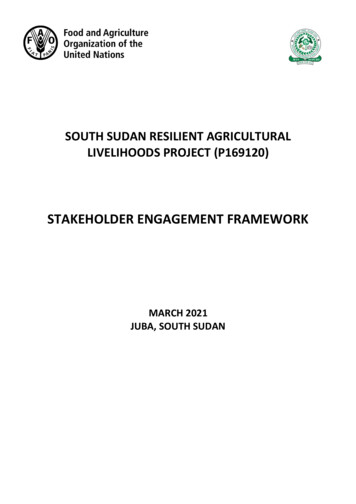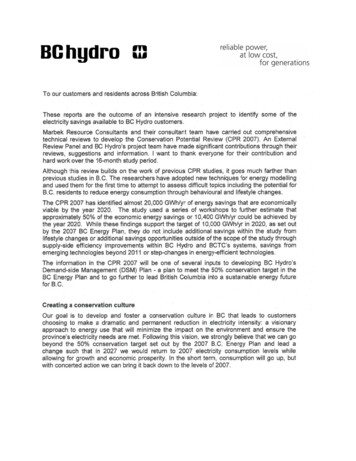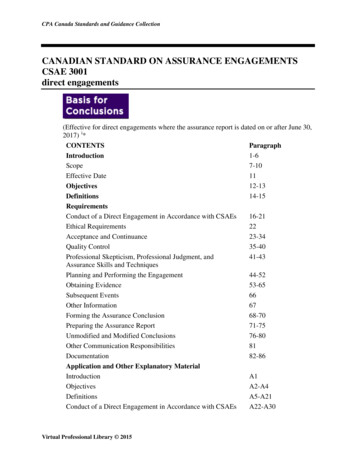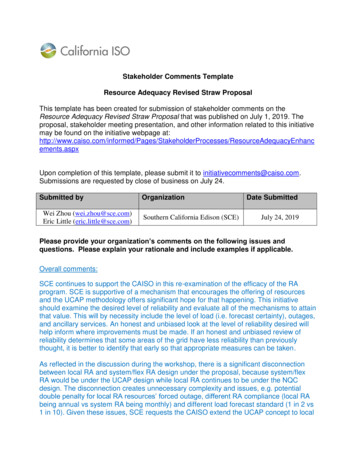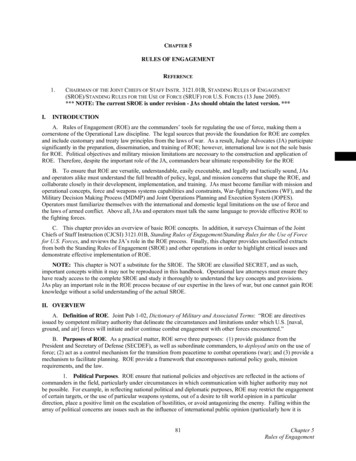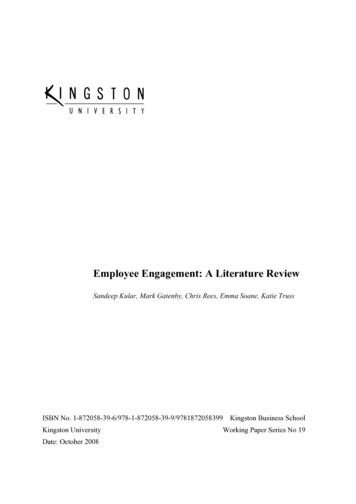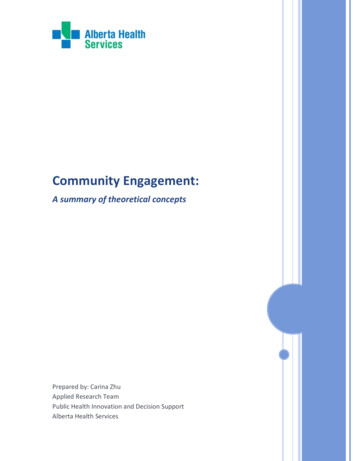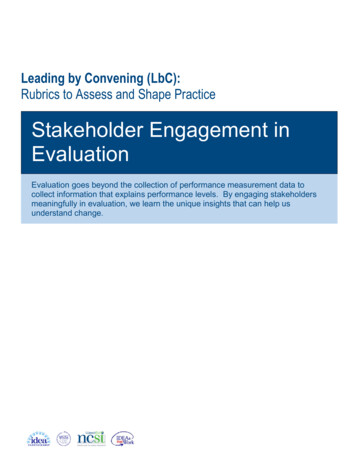
Transcription
Leading by Convening (LbC):Rubrics to Assess and Shape PracticeStakeholder Engagement inEvaluationEvaluation goes beyond the collection of performance measurement data tocollect information that explains performance levels. By engaging stakeholdersmeaningfully in evaluation, we learn the unique insights that can help usunderstand change.
Leading by Convening (LbC): Rubrics to Assess and Shape Practice — Coalescing Around Evidence-Based Practices (EBP)About the LbC RubricsEach LbC rubric describes a set of observable behaviors focused on a change in the practice of authentic stakeholderengagement. The rubrics can be used by teams to: discuss authentic engagement from the viewpoint of the stakeholders; assess current levels of interaction; guide future interaction; routinely assess changes in perception and practice; and chronicle changes in outcomes as engagement deepens.Using the LbC RubricsThe image below displays a graphic representation of the LbC framework and a rubric that is derived from it. LbC isbased on three habits of interaction (Coalescing Around Issues, Ensuring Relevant Participation and Doing WorkTogether). These habits unpack into three elements of interaction (Adaptive, Technical, and Operational) that furtherunpack into four depths of interaction (Informing, Networking, Collaborating and Transforming).The LbC rubrics use the operational elements and depths of interaction to help leaders and teams engage theirstakeholders more actively. Rubrics typically list a criteria or behavior in the left column and describe levels ofperformance in columns moving to the right. This arrangement creates cells that describe the performance at each levelfor each criterion. In the LbC rubric below, the criterion column is called an “operational decision.” Operational decisionsresult when a team examines both the technical and adaptive elements of the change it envisions and defines severalimportant aspects of interaction that they will attend to over time.
Leading by Convening (LbC): Rubrics to Assess and Shape Practice — Coalescing Around Evidence-Based Practices (EBP)Each rubric is interactive. Follow the image below to see how you can interact with the rubrics as you move towardsgreater depths of interaction.
Leading by Convening (LbC): Rubrics to Assess and Shape Practice — Coalescing Around Evidence-Based Practices (EBP)RUBRICStakeholder Engagement in EvaluationOPERATIONALDECISIONSLEVEL 1LEVEL 2LEVEL 3LEVEL 4Key actions and behaviorsthat require your attentionINFORMING LEVELsharing / disseminatingone-way communicationNETWORKING LEVELexchangingtwo-way communicationCOLLABORATING LEVELengagingworking together on the issue overtimeTRANSFORMING LEVELcommittingapproaching issues throughengagement & consensus buildingAA1A2A3A4Stakeholderparticipation as anunderlying value inevaluation.Convener/state lead agencyoutlines the evaluation goal andprocess. They commission anexternal evaluation and inform thestakeholders that an evaluation isunderway.Convener/state lead agencyinvites a core group to review andgive input on the evaluationdesign, focus, and process. Theyhave a dialogue on the evaluation.Convener/state lead agency,together with an expanded groupof stakeholders, buildunderstanding of the goals anduse of evaluation. There is anexpectation that stakeholders willinform evaluation efforts.Convener/state lead agencyensure that those most impactedby the evaluation’s results are themost engaged in the evaluationprocess. There is an expectationthat stakeholders are partners inevaluation.BB1B2B3B4Evaluation practicesinclude knowledgethat resides withpractitioners andconsumers.Convener/state lead agencydescribes the data, groundingassumptions, theory of action, andlogic model behind the evaluationplan.Convener/state lead agencydiscusses data, theory of action,logic model, activities, andmeasures designed to inform theevaluation with stakeholders.Convener/state lead agency andan expanded group ofstakeholders examine the data todevelop the theory of action, logicmodel, activities, and measures.They meet frequently enough todetermine the need for mid-coursecorrections.Convener/state lead agencyensures that are stakeholders arealways partners in evaluation.Those with the most to lose orgain are involved in acting onevaluation information to improvethe system.
Leading by Convening (LbC): Rubrics to Assess and Shape Practice — Coalescing Around Evidence-Based Practices (EBP)BACK TO FULL RUBRICA1 – Resources to move from Informing to NetworkingYou are on the Informing Level. You are working towards the Networking Level.OPERATIONALDECISIONSLEVEL 1LEVEL 2LEVEL 3LEVEL 4Key actions and behaviorsthat require your attentionINFORMING LEVELsharing / disseminatingone-way communicationNETWORKING LEVELexchangingtwo-way communicationCOLLABORATING LEVELengagingworking together on the issue overtimeTRANSFORMING LEVELcommittingapproaching issues throughengagement & consensus buildingAA1A2A3A4Convener/state lead agencyoutlines the evaluation goal andprocess. They commission anexternal evaluation and inform thestakeholders that an evaluation isunderway.Convener/state lead agencyinvites a core group to review andgive input on the evaluationdesign, focus, and process. Theyhave a dialogue on the evaluation.Convener/state lead agency,together with an expanded groupof stakeholders, buildunderstanding of the goals anduse of evaluation. There is anexpectation that stakeholders willinform evaluation efforts.Convener/state lead agencyensure that those most impactedby the evaluation’s results are themost engaged in the evaluationprocess. There is an expectationthat stakeholders are partners inevaluation.Stakeholderparticipation as anunderlying value inevaluation.Links to useful tools in LbC Meet the Stakeholders: Find the groups that have deep and durable connections related to the issue. Reach outand identify potential partners at the practice level. Engaging Everybody: Outline roles and expectations for engaging in shared work on your issue; help peopleself-select a role that suits their level of commitment. Learn the Language Make the Connection: Shared interests or concerns may be masked by the use of differentvocabulary, program names and funding. Download the book, Leading by Convening.Resources beyond LbCThe Center to Improve Project Performance at Westat hosted a session at the IDEA Data Center Institutes that offersguidance on assembling a team to evaluate state improvement plans (See Handout on working with third partyevaluators). Guidelines for Working with Third-Party EvaluatorsDeveloping a logic model can be a very useful way of bringing together existing evidence about a program, clarifyingwhere there is agreement or disagreement about how the program is understood to work and where there are gaps inthe evidence.
Leading by Convening (LbC): Rubrics to Assess and Shape Practice — Coalescing Around Evidence-Based Practices (EBP)This website presents a comprehensive listing of practical guides, examples, and scholarly articles for preparing logicmodels with stakeholder engagement. Evaluation Logic Model BibliographyAn evaluation design is simply a plan for conducting your evaluation. This resource opens your team to a toolkit forchoosing an evaluation design and completing a logic plan.This packet, developed through the Corporation for National and Community Service, describes steps to collectmeaningful information for performance measurement. Collecting Performance Measurement DataTips from implementers and stakeholders Use your networks to find as many stakeholders as possible and involve them in the evaluation from this pointforward. Generate an infographic to visualize the goal and the process that is intended to lead to that goal. Create a short description to distribute to stakeholders about the evaluation in understandable and conciselanguage. Avoid jargon. Prioritize outreach efforts and promote dialogue to develop an engagement strategy. Stakeholders can develop a fact sheets that provide background information, explaining the ways different groupsexpress the same issue. Review and consider ideas presented in the IDEA Partnership Dialogue Guide. Plan your evaluation and work with the stakeholders to create the best possible evaluation communication plan. Articulate the value of stakeholder participation in the invitation to stakeholders who are not present at the initialmeeting. Continue to reach out to groups that are important to the success of your evaluation efforts, even if they do notrespond to the initial invitation (e.g., ask who else cares about this issue and why?).
Leading by Convening (LbC): Rubrics to Assess and Shape Practice — Coalescing Around Evidence-Based Practices (EBP)BACK TO FULL RUBRICA2 – Resources to move from Networking to CollaboratingYou are on the Networking Level. You are working towards the Collaborating Level.OPERATIONALDECISIONSLEVEL 1LEVEL 2LEVEL 3LEVEL 4Key actions and behaviorsthat require your attentionINFORMING LEVELsharing / disseminatingone-way communicationNETWORKING LEVELexchangingtwo-way communicationCOLLABORATING LEVELengagingworking together on the issue overtimeTRANSFORMING LEVELcommittingapproaching issues throughengagement & consensus buildingAA1A2A3A4Convener/state lead agencyoutlines the evaluation goal andprocess. They commission anexternal evaluation and inform thestakeholders that an evaluation isunderway.Convener/state lead agencyinvites a core group to review andgive input on the evaluationdesign, focus, and process. Theyhave a dialogue on the evaluation.Convener/state lead agency,together with an expanded groupof stakeholders, buildunderstanding of the goals anduse of evaluation. There is anexpectation that stakeholders willinform evaluation efforts.Convener/state lead agencyensure that those most impactedby the evaluation’s results are themost engaged in the evaluationprocess. There is an expectationthat stakeholders are partners inevaluation.Stakeholderparticipation as anunderlying value inevaluation.Links to useful tools in LbC Building Engagement: Use this list of stakeholder engagement activities to find ways people can contribute toshared work. Let people choose what activities have value for them. What’s in it for Me: Participation is not the same as engagement. This activity helps identify the difference. Workwith partners to develop simple methods of tracking the progress of engagement activities that are expected tobuild capacity. Four Simple Questions: Use these questions to explore common interests or concerns with stakeholder groups.Outline activities to pursue together. Download the book, Leading by Convening.Resources beyond LbCThe World Health Organization has a step-by-step guide (found in Section 2 of the Global Health Alliance Toolkit) forconducting a stakeholder analysis. Stakeholder Analysis GuidelinesThe U.S. Agency on International Development developed a technique to identify and assess the importance of keypeople, groups, or institutions in an evaluation. Evaluation Stakeholder Analysis
Leading by Convening (LbC): Rubrics to Assess and Shape Practice — Coalescing Around Evidence-Based Practices (EBP)This evaluation manual describes the steps and phases of Participatory Program Evaluation. Pages 19-21 specificallycover topics of engaging stakeholders when forming an evaluation team. The entire 86-page manual is dedicated toinvolving program stakeholders in the evaluation.This workbook provides a template for developing evaluation questions that engage stakeholders’ interest in theprocess. Evaluation WorkbookThis website includes a description of Social Network Analysis (SNA) and when it might be used in an evaluation. SNAhelps describe and measure links and relationships among stakeholders or groups. Social Network AnalysisTips from implementers and stakeholders At this level, it is important to gauge which groups are most vested in the results of the shared work and prioritizeoutreach and engagement activities. Begin to collect baseline information and simple processes for stakeholders to contribute to measuring progress. Develop a rhythm of interaction that allows stakeholders to check in and report data on progress.
Leading by Convening (LbC): Rubrics to Assess and Shape Practice — Coalescing Around Evidence-Based Practices (EBP)BACK TO FULL RUBRICA3 – Resources to move from Collaborating to TransformingYou are on the Collaborating Level. You are working towards the Transforming Level.OPERATIONALDECISIONSLEVEL 1LEVEL 2LEVEL 3LEVEL 4Key actions and behaviorsthat require your attentionINFORMING LEVELsharing / disseminatingone-way communicationNETWORKING LEVELexchangingtwo-way communicationCOLLABORATING LEVELengagingworking together on the issue overtimeTRANSFORMING LEVELcommittingapproaching issues throughengagement & consensus buildingAA1A2A3A4Convener/state lead agencyoutlines the evaluation goal andprocess. They commission anexternal evaluation and inform thestakeholders that an evaluation isunderway.Convener/state lead agencyinvites a core group to review andgive input on the evaluationdesign, focus, and process. Theyhave a dialogue on the evaluation.Convener/state lead agency,together with an expanded groupof stakeholders, buildunderstanding of the goals anduse of evaluation. There is anexpectation that stakeholders willinform evaluation efforts.Convener/state lead agencyensure that those most impactedby the evaluation’s results are themost engaged in the evaluationprocess. There is an expectationthat stakeholders are partners inevaluation.Stakeholderparticipation as anunderlying value inevaluation.Links to useful tools in LbC How People Are: Change is hard for most people and support is important as stakeholders work through theprocess. Use quote #2 to discuss stakeholder involvement in implementing change. Then ask participants toreflect on the implications for stakeholder engagement in evaluation. Problems Come Bundled: Identify some of the technical and adaptive challenges associated with expandedstakeholder engagement in evaluation and begin generating potential solutions. Defining Our Core: Express your driving purpose and share it simply with others. This exercise can also helpyour team describe the evaluation work in straightforward ways that are understandable to potential partners andthe public. Download the book, Leading by Convening.Resources beyond LbCThis website provides an array of resources to help convey the value of involving stakeholders. It includes practicalguidelines on who to include, strategies on how to involve, and engage stakeholders, and specific activities to use atvarious points in the process. Identify and Engage Stakeholders
Leading by Convening (LbC): Rubrics to Assess and Shape Practice — Coalescing Around Evidence-Based Practices (EBP)A theory of change outlines how to create that change. It is an essential part of a successful community transformationeffort.A logic model can keep participants in the effort moving in the same direction by providing common language and pointof reference. Developing a Logic Model or Theory of ChangeThis guide outlines the value of stakeholder engagement in the evaluation process and provides the reader with a fivestep process for involving stakeholders in developing evaluation questions. It includes a set of four worksheets tofacilitate this process. Practical Guide for Engaging Stakeholders In Developing EvaluationThis workbook provides a template for developing evaluation questions that engage stakeholders’ interest in theprocess. Designing and Reporting Mixed Methods in EvaluationThis document can be used to get started with participatory data analysis. By involving stakeholders in analysis,evaluators can better understand the context and meaning of the data, resulting in added nuance and richness of thefinal evaluation report. Participatory Analysis: Expanding Stakeholder Involvement in EvaluationTips from implementers and stakeholders Consider what key competencies are needed to lead collaborative efforts and group people with complementaryskills or knowledge. Talk together about how to leverage skills and influence when taking collective action. Thinkabout the people and the groups involved in key activities and ask: Who brings group facilitation skills? Ask yourself: Have we allocated time/ resources for training partners on the basics of evaluation methods andvocabulary?
Leading by Convening (LbC): Rubrics to Assess and Shape Practice — Coalescing Around Evidence-Based Practices (EBP)BACK TO FULL RUBRICA4 – Resources to sustain TransformationYou are on the Transforming Level. Continue to engage your stakeholders to sustain your progress.OPERATIONALDECISIONSLEVEL 1LEVEL 2LEVEL 3LEVEL 4Key actions and behaviorsthat require your attentionINFORMING LEVELsharing / disseminatingone-way communicationNETWORKING LEVELexchangingtwo-way communicationCOLLABORATING LEVELengagingworking together on the issue overtimeTRANSFORMING LEVELcommittingapproaching issues throughengagement & consensus buildingAA1A2A3A4Convener/state lead agencyoutlines the evaluation goal andprocess. They commission anexternal evaluation and inform thestakeholders that an evaluation isunderway.Convener/state lead agencyinvites a core group to review andgive input on the evaluationdesign, focus, and process. Theyhave a dialogue on the evaluation.Convener/state lead agency,together with an expanded groupof stakeholders, buildunderstanding of the goals anduse of evaluation. There is anexpectation that stakeholders willinform evaluation efforts.Convener/state lead agencyensure that those most impactedby the evaluation’s results are themost engaged in the evaluationprocess. There is an expectationthat stakeholders are partners inevaluation.Stakeholderparticipation as anunderlying value inevaluation.Links to useful tools in LbC Measuring Progress: Demonstrates how to turn qualitative measures into quantitative data. Develops actionplans that address ways in which progress can be measured. A Quick Chronology of Engagement: Helps stakeholders to reflect on their work together, tell the story of theirengagement and describe the value of their collaboration. Your Brand: Tells how to discuss and create a brand with the stakeholders, make adjustments over time, andsustain the work through changes in leadership and other developments. Download the book, Leading by Convening.Resources beyond LbCThis website provides vignettes of community-based stakeholder engagement methods for data collection that can beused in the evaluation. Research Methods VignettesThis guide is organized into two sections: (1) Section One provides information to facilitate a theory of change processwith a community group, and (2) Section Two is a resource toolbox for the theory of change facilitator. A Community Builders Approach to Theory of Change
Leading by Convening (LbC): Rubrics to Assess and Shape Practice — Coalescing Around Evidence-Based Practices (EBP)This guide outlines the value of stakeholder engagement in evaluating processes and provides a five-step process forinvolving stakeholders in developing evaluation questions. It includes a set of four worksheets to facilitate this process. Practical Guide for Engaging Stakeholders in Developing EvaluationSocial Network Analysis in evaluation helps describe and measure links and relations among stakeholder groups. Thiswebsite provides a description of SNA and how to include it in an evaluation.Consulting firm FSG highlights nine evaluation propositions that can help leaders navigate the unique characteristics ofcomplex systems, improve their evaluation practice, and better serve the needs of the social sector. Evaluating ComplexityTips from implementers and stakeholders Involve primary users of evaluation reports in determining evaluation methods. Learn about empowerment evaluation methods, using processes that help people develop skills so they canbecome independent problem solvers and decision makers. Conduct focus groups with stakeholder groups that are affected by the evaluation results. Post evaluation results on websites with request for anonymous feedback.
Leading by Convening (LbC): Rubrics to Assess and Shape Practice — Coalescing Around Evidence-Based Practices (EBP)BACK TO FULL RUBRICB1 – Resources to move from Informing to NetworkingYou are on the Informing Level. You are working towards the Networking Level.OPERATIONALDECISIONSLEVEL 1LEVEL 2LEVEL 3LEVEL 4Key actions and behaviorsthat require your attentionINFORMING LEVELsharing / disseminatingone-way communicationNETWORKING LEVELexchangingtwo-way communicationCOLLABORATING LEVELengagingworking together on the issue overtimeTRANSFORMING LEVELcommittingapproaching issues throughengagement & consensus buildingBB1B2B3B4Convener/state lead agencydescribes the data, groundingassumptions, theory of action, andlogic model behind the evaluationplan.Convener/state lead agencydiscusses data, theory of action,logic model, activities, andmeasures designed to inform theevaluation with stakeholders.Convener/state lead agency andan expanded group ofstakeholders examine the data todevelop the theory of action, logicmodel, activities, and measures.They meet frequently enough todetermine the need for mid-coursecorrections.Convener/state lead agencyensures that are stakeholders arealways partners in evaluation.Those with the most to lose orgain are involved in acting onevaluation information to improvethe system.Evaluation practicesinclude knowledgethat resides withpractitioners andconsumers.Links to useful tools in LbC Grounding Assumptions: Develop shared beliefs and understandings to serve as the foundation of collaborativeefforts. One-Way, Two-Way Learning: Interaction demands a two-way process; transform one-way processes into twoway learning activities. Measuring Progress: Develop consensus about the beginning and the end result. Capture deepeningengagement. Download the book, Leading by Convening.Resources beyond LbCThis presentation from the IDEA Data Center Institute offers guidance on assembling a team, including the types ofskills, and knowledge needed to build an effective team. Building an Effective SSIP Evaluation TeamThe purpose of this checklist is to aid in developing effective and appropriate evaluation questions and in assessing thequality of existing questions. It identities characteristics of good evaluation questions, based on the relevant literature,and experience with evaluation design, implementation and use.
Leading by Convening (LbC): Rubrics to Assess and Shape Practice — Coalescing Around Evidence-Based Practices (EBP) Evaluation Questions ChecklistA practical guide for determining the meaningful measures for program evaluation to enhance its usefulness for allaudiences. Measuring What MattersThis resource looks at some of the ways to structure an evaluation to examine whether the program is working, andexplores how to choose the one that best meets stakeholder needs. These arrangements for discovery are known asevaluation designs. Selecting an Appropriate Design for EvaluationEvaluation design is often an iterative process that prioritizes the evaluation questions based on resources and timeavailable. This resource presents a practical Evaluation Design Checklist. Evaluation DesignThis document published by Better Evaluation describes steps to collect and analyze data to answer causal questionsabout what has produced outcomes and impacts that have been observed. Understand Causes of Outcomes and ImpactThis web-based evaluation toolkit outlines what should be considered when determining data collection surveys. Youwill also learn about several data collection methods and tools. Information on how to best select a sample and increaseparticipation rates is provided. Evaluation ToolkitProvides information about how to communicate evaluation results.Tips from implementers and stakeholders Verify with stakeholders that their knowledge and experience are included in the evaluation. Communicate with stakeholders frequently and create support for the evaluation by conveying the value.
Leading by Convening (LbC): Rubrics to Assess and Shape Practice — Coalescing Around Evidence-Based Practices (EBP)BACK TO FULL RUBRICB2 – Resources to move from Networking to CollaboratingYou are on the Networking Level. You are working towards the Collaborating Level.OPERATIONALDECISIONSLEVEL 1LEVEL 2LEVEL 3LEVEL 4Key actions and behaviorsthat require your attentionINFORMING LEVELsharing / disseminatingone-way communicationNETWORKING LEVELexchangingtwo-way communicationCOLLABORATING LEVELengagingworking together on the issue overtimeTRANSFORMING LEVELcommittingapproaching issues throughengagement & consensus buildingBB1B2B3B4Convener/state lead agencydescribes the data, groundingassumptions, theory of action, andlogic model behind the evaluationplan.Convener/state lead agencydiscusses data, theory of action,logic model, activities, andmeasures designed to inform theevaluation with stakeholders.Convener/state lead agency andan expanded group ofstakeholders examine the data todevelop the theory of action, logicmodel, activities, and measures.They meet frequently enough todetermine the need for mid-coursecorrections.Convener/state lead agencyensures that are stakeholders arealways partners in evaluation.Those with the most to lose orgain are involved in acting onevaluation information to improvethe system.Evaluation practicesinclude knowledgethat resides withpractitioners andconsumers.Links to useful tools in LbC Give Value First: Allows partners to express their expectations as they enter a learning partnership. Examinehow expectations shape a potential partnership. Web of Connections: Articulate the various perspectives on a shared issue. Think about why the core leadershipteam identifies certain groups as potential partners and why those groups might want to become a partner in thework. Co-Creating Tools: Bring people together to co-create materials to be used and promoted by all the partners. Download the book, Leading by Convening.Resources beyond LbCDifferent points in the program cycle may require different types of evaluation designs. This guide provides practicalexamples and steps for selecting an evaluation design to help the team answer evaluation questions. Study Designs for EvaluationEvaluation design is often an iterative process that prioritizes the evaluation questions based on resources and timeavailable. This resource presents a practical design checklist. Evaluation Design Checklist
Leading by Convening (LbC): Rubrics to Assess and Shape Practice — Coalescing Around Evidence-Based Practices (EBP)This packet, developed through the Corporation for National and Community Service, describes steps to collectmeaningful information for performance measurement. Collecting Performance Measurement DataThe Centers for Disease Control report demonstrates how the evaluation report can serve as a bridge betweenconducting the evaluation and use of the evaluation findings. Developing an Effective Evaluation ReportLogic modeling can greatly enhance the participatory role and usefulness of evaluation as a management learning tool.The Kellogg Foundation offers a guide to developing and using logic models as an important step in building communitycapacity and strengthening community voice. Logic Model GuideTips from implementers and stakeholders To help move to the Collaboration Level, the LbC Learn the Language tool can be adapted to encourage the groups that arebeginning to see connections between their work to explore what success would look like if they worked together. Remember the logic model is just a graphic representation of how the program is supposed to work. There mustbe rich discussion within the team on what underlies the graphic elements. Be a skeptic – ask why membersbelieve the program will work as represented.
Leading by Convening (LbC): Rubrics to Assess and Shape Practice — Coalescing Around Evidence-Based Practices (EBP)BACK TO FULL RUBRICB3 – Resources to move from Collaborating to TransformingYou are on the Collaborating Level. You are working towards the Transforming Level.OPERATIONALDECISIONSLEVEL 1LEVEL 2LEVEL 3LEVEL 4Key actions and behaviorsthat require your attentionINFORMING LEVELsharing / disseminatingone-way communicationNETWORKING LEVELexchangingtwo-way communicationCOLLABORATING LEVELengagingworking together on the issue overtimeTRANSFORMING LEVELcommittingapproaching issues throughengagement & consensus buildingBB1B2B3B4Convener/state lead agencydescribes the data, groundingassumptions, theory of action, andlogic model behind the evaluationplan.Convener/state lead agencydiscusses data, theory of action,logic model, activities, andmeasures designed to inform theevaluation with stakeholders.Convener/state lead agency andan expanded group ofstakeholders examine the data todevelop the theory of action, logicmodel, activities, and measures.They meet frequently enough todetermine the need for mid-coursecorrections.Convener/state lead agencyensures that are stakeholders arealways partners in evaluation.Those with the most to lose orgain are involved in acting onevaluation information to improvethe system.Evaluation practicesinclude knowledgethat resides withpractitioners andconsumers.Links to useful tools in LbC Seeds of Trust: Show sincerity in direct and indirect ways and identify small changes that build trust amongstakeholders. Developing a PowerPoint and Notes: Develop content for a PowerPoint presentation that can be shared by allthe partners. When cross-stakeholder groups deliver common messages to the field, it models collaborationacross roles and levels of the system (e.g., state, region, local). Dialogue Guides: Help partners and their networks identify and discuss topics to build common knowledge and ashared understanding that are important i
Leading by Convening (LbC): Rubrics to Assess and Shape Practice — Coalescing Around Evidence-Based Practices (EBP) About the LbC Rubrics . Each LbC rubric describes a set of observable behaviors focused on a change in the practice of authentic stakeholder
